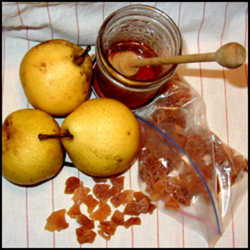When the idea of candying fruit made its way to Europe (by way of the Arab tradition), sugar was not available, so early recipes used a honey syrup. Even after sugar became part of the European diet, it was still an expensive colonial export, so candied fruit was an expensive treat. Sugar may no longer be expensive, but candied fruit retains that feel of something special.
You can see glace fruits on display in European style candy shops - but nothing beats the satisfaction of making your own. And if all you have ever tasted is the grocery store-style glace fruits that come in tubs, then you will be in for a real treat. While the processing of those fruits tends to strip away the individual characteristics and flavors, leaving only a benign sweetness, syrup processed glace fruits simply replace the water in the fruits with sugar, letting the fruit's natural character shine through.
Candying fruit does have transformative effects, bringing out hidden notes in the flavors. It can also allow you to make treats out of what would otherwise be unpalatable - such as strips of orange peel dipped in chocolate.
 |  |
When dealing with citrus, you usually candy strips of peel. If you tie it into knots while it is still pliable, it makes a lovely garnish for cupcakes. Candying citrus peel, especially, is a way to prevent waste, as you can remove the strips of peel before juicing the inside of the orange or lemon. One exception to this is kumquats , which you can cut into halves, or even candy whole. Another is citron, a citrus fruit which is basically all pith. For candying, you remove the inside pulp and cut the rest into wedges. Minced candied citron is often added to Italian cakes and cookies.
If you candy something other than citrus, try to choose firm fruits (such as cherries and apples), and use the best specimens you can find. Whatever fruit you choose, make sure you remove any inedible portions, such as stems. A cherry pitter comes in handy if you wish to keep cherries hole while removing the pits. Larger fruits should be cut into chunks or slices to make the candying process more effective.
You can mince together your favorite glace fruits for additions to fruit cakes, and the Milanese sweet loaf called Panettone. Candied apple, pear, peach, apricots, cherry, fig, and plums produced in certain regions of Spain (known as Frutas de Aragón) are sometimes steeped in liqueur and may be covered in chocolate and eaten by themselves. You can make a variation on this by stirring candied fruit into nut clusters or sprinkling minced pieces onto the top of wet chocolate bark.
Traditional processes can involve repeatedly soaking the fruit in progressively stronger sugar solutions over a course of days or even months. This results in a completely dry fruit often with a powdery surface, or with a surface coated with sugar crystals (the fruit may be rolled in sugar after the last soaking). An alternate method for glace fruit leaves the fruit pliable and sometimes covered with a thick syrup. Fruits preserved by these methods may not be shelf stable, and should be refrigerated. Try to consume home-made versions of these products within a few weeks of making them.
If you are pressed for time, you can candy your fruit using a single sugar bath. For this method, you boil the fruit in the sugar syrup until it achieves your desired consistency. Then allow it to dry completely on a rack over waxed paper.
I hope you give candying your own fruit a try, especially if you use fruits you have grown yourself. It is so simple to do, yet it creates impressive results that can add flavor to all sorts of treats.
















